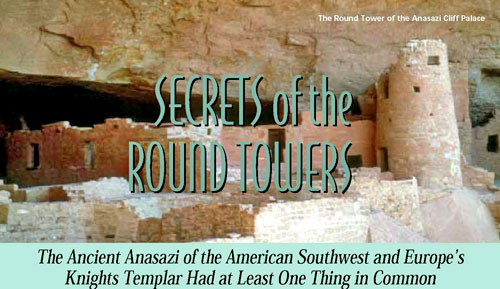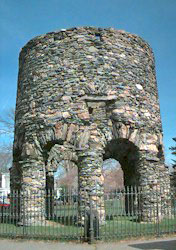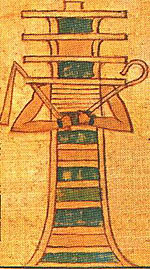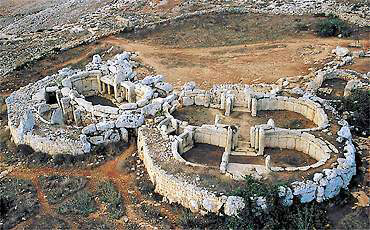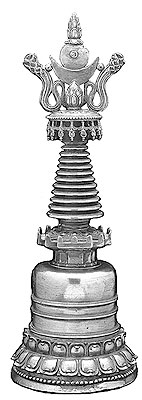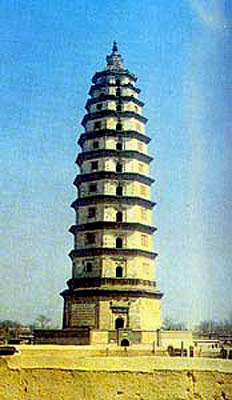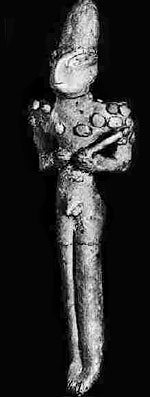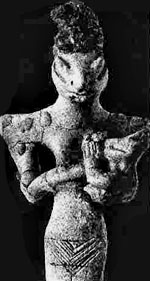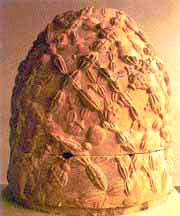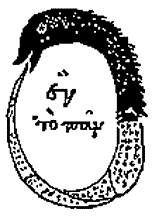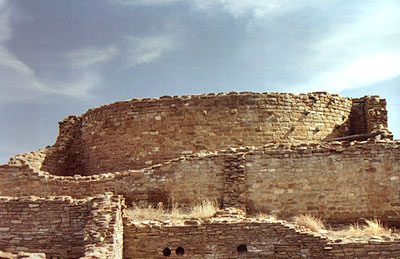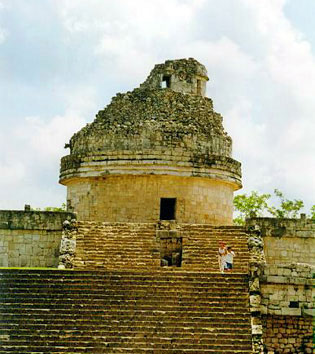|
in Atlantis Rising magazine, Issue 46 from TheOrionZone Website
Round Towers Around the Globe
The common figure linking these structures, however,
proves to be the serpent or snake. Cultures as diverse as
the Celts of Ireland and
the Hopi of Arizona associate this
religiously and psychologically charged reptile with round temples
reaching toward moisture-laden storm clouds.
In Sacred Geometry (1982), Nigel Pennick explains the symbolism of the circular form:
Most of Europe’s Gothic cathedrals were
constructed using designs uncovered by this fraternal organization
in a 12th century excavation of Jerusalem’s Temple Mount.
Round tower at
Newport, RI Even earlier the Phoenicians may have spread this unique architectural feature globally in homage to Baal, the fertility deity of rain, thunder, and lightning. In Jesus, Last of the Pharaohs (1999), Ralph Ellis avers that round towers were modeled after the Egyptian Benben tower located in the Phoenix Temple at Heliopolis. (The Phoenicians were named after the mythical bird that rose from its ashes.)
Morphologically similar to round towers, the djed pillar was known as the “backbone of Osiris.” This column symbolically channeled kundalini (serpent energy) up the vertebra.
Egyptian djed pillar,
anthropomorphized Over 7,000 circular towers called Nuraghi from the second millennium BC are found on the island of Sardinia north of the ancient Phoenician city of Carthage (modern-day Tunis).
In addition, Graham Hancock (Underworld, 2002) reminds us that the Gigantija, or Giants’ Tower, was constructed on the Maltese island of Gozo a millennium before the Great Pyramid. Its elliptical chambers at one time possibly supported towers.
A stone relief discovered at the site depicts a serpent.
Gigantija
Perhaps serving as a model for the minaret, the Radkan Tower in northeastern Iran is circular with a conical cap.
Archeoastronomer Manochehr
Arian (Zia) has found solstice and equinox alignments for this
structure, suggesting a sophisticated observation of the sky going
back 800 years or more.
A monk eventually discovered her true nature and summoned the elemental powers to imprison her inside Thunder Pagoda for a thousand years.
Stupa with snake-like Brick pagoda, Kaiyuan, China
ornamentation on top
The Serpent and the Circle
Andrew Collins' book From the Ashes of Angels (2001) refers to the Testament of Amram, an apocalyptic fragment from the Dead Sea Scrolls. Amram, the father of Moses, perceives in a dream a Watcher called Belial.
This creature is,
As an appellation of Satan, the name Belial from II Corinthians 6:15 suggests a figure who is lawless, worthless, or reckless.
The word “serpent,” Collins adds, is synonymous with both the Watchers found in the Book of Enoch and the Nephilim.
The latter denotes the “giants in the earth” from Genesis 6:4.
Omphalos at Delphi in Greece Ouroboros Codex Marcianus, 11th century AD
For instance, the omphalos, a Greek word meaning “navel,” is
the oracular Stone of Splendor at Delphi. This sacred center where
tellurian serpent forces would accumulate had the ability to
directly communicate with the gods.
At the Chetro Ketl pueblo ruin in Chaco Canyon, New Mexico, a round “tower kiva” rises three stories high. Circular towers at Kin Kletso and Tsin Kletsin in the same canyon are also found.
The outlying villages of Salmon Ruin 40 miles due north and Kin Ya’a Ruin 25 miles due south contain similar structures.
Tower kiva at Chetro
Ketl, Chaco Canyon, New Mexico Round towers are located as well at the spectacular cliff dwellings in Mesa Verde National Park of southwestern Colorado.
These include Cliff Palace, Sun Temple, Cedar Tree Tower, and Far View Community. The Cajon Group at Hovenweep National Monument in southeastern Utah also exemplifies this type of ceremonial structure. Circular buildings are found at Mummy Cave Ruin in Canyon de Chelly National Monument and at Wukoki Ruin at Wupatki National Monument.
Both of these sites located in Arizona
are traditional homes of the Snake Clan.
Wukoki is also a former house of the Snake Clan.
Caracol observatory
at Chichen Itzá, Yucatan, Mexico The Hopi refer to round towers as “snake houses.” In a narrative describing the origin of the Snake Clan, the wife of the culture hero Tiyo gives birth to a brood of venomous snakes, which keeps getting loose.
Masau’u (Hopi god of death, the earth, and the Underworld - also spelled Masau or Masaw) explains to the snake mother why her children no longer can have a house in which to live.
We are obviously talking not about rattlesnake pens but either the temples or domiciles of a dangerous, snake-like race.
The same Hopi myth concludes with an offering to the recovered snakes:
Chüa is the Hopi name of the worshipped
snake that initiated their biennial rain ceremony still performed on
the Arizona high desert. This name is similar to “Chna,” an English
transliteration of the Greek word referring to the Phoenician land
of Canaan. The biblical Anakim were known to have hailed from
southern Canaan.
The Hopi offerings of
earrings and necklaces are particularly significant because the Hopi
term naaqa means “turquoise necklace” or “ear pendant ” and
anaaq
means “ouch!", an interjection used to express the extreme pain
caused by snakebite.
Coincidentally, archaeologists found an
example of this artifact in an ancient pueblo ruin known as Snaketown near modern-day Phoenix.
Perhaps we are uncovering more questions than answers. Nonetheless, round towers survive as a testament to the awesome spiritual power of the Knights of the Round Temple.
Their serpentine eyes gaze across the centuries, now and then sending a shiver up the spine.
|

